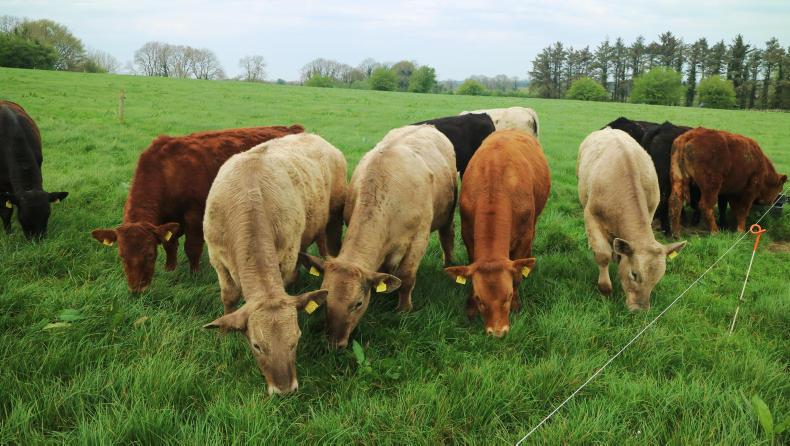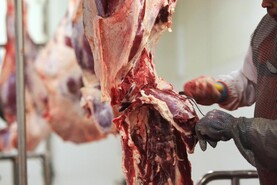Newford Farm is dealing with much trickier grazing conditions in recent days. This comes after a spell of excellent weather at Easter which led to a spike in grass growth rates and the first silage of 2019 being made.
There were a number of paddocks identified in the previous fortnight for taking out of the rotation and these were mowed, allowed to wilt for a little over 24 hours and baled during Easter week.
A further spike in grass growth rates around Easter weekend saw some paddocks with a heavy cover of grass record growth rate of 100kg DM/ha. Growth rates over the three blocks during that period are detailed in Table 1.
The farm made a quick decision at the start of the week to take further paddocks out of the rotation with a number gone too strong for grazing, while paddocks which were targeted for grazing in the following days also came much quicker which allowed this to take place.
The second cut was a quicker turnaround with inclement weather forecast. Grass was mowed on Tuesday and baled on Wednesday.
In total, there were 27 acres mowed across the Newford, Gort na Habhainn and Tuohy’s land block. This yielded excellently for surplus paddocks, with 190 bales saved or an average of seven bales per acre.
It will provide over 50% of the winter feed requirement for weanlings and will be prioritised for feeding to these.
Fertiliser will be applied to these areas as soon as weather allows to ensure they are back into the rotation quickly. All paddocks have received 70 units of nitrogen to date and urea will continue to be applied for another round before switching to compound fertilisers.

A spike in grass growth rates and heavy rainfall is making grazing management trickier but by and large it has been an excellent start to 2019 in Newford Farm.
Slurry will also be targeted when possible to areas where silage has been cut to address P and K offtake with silage.
Grazing management
Grazing has become much trickier in the last 48 hours following heavy rainfall on Friday and heavy showers on Saturday. Cows and calves and heifers/steers are being moved quicker to new paddocks to avoid damage to swards while also helping to keep cattle content. Dividing paddocks is also helping in this regard to optimise utilisation.
Read more
Newford update: final plans in place for breeding 2019
Newford Farm is dealing with much trickier grazing conditions in recent days. This comes after a spell of excellent weather at Easter which led to a spike in grass growth rates and the first silage of 2019 being made.
There were a number of paddocks identified in the previous fortnight for taking out of the rotation and these were mowed, allowed to wilt for a little over 24 hours and baled during Easter week.
A further spike in grass growth rates around Easter weekend saw some paddocks with a heavy cover of grass record growth rate of 100kg DM/ha. Growth rates over the three blocks during that period are detailed in Table 1.
The farm made a quick decision at the start of the week to take further paddocks out of the rotation with a number gone too strong for grazing, while paddocks which were targeted for grazing in the following days also came much quicker which allowed this to take place.
The second cut was a quicker turnaround with inclement weather forecast. Grass was mowed on Tuesday and baled on Wednesday.
In total, there were 27 acres mowed across the Newford, Gort na Habhainn and Tuohy’s land block. This yielded excellently for surplus paddocks, with 190 bales saved or an average of seven bales per acre.
It will provide over 50% of the winter feed requirement for weanlings and will be prioritised for feeding to these.
Fertiliser will be applied to these areas as soon as weather allows to ensure they are back into the rotation quickly. All paddocks have received 70 units of nitrogen to date and urea will continue to be applied for another round before switching to compound fertilisers.

A spike in grass growth rates and heavy rainfall is making grazing management trickier but by and large it has been an excellent start to 2019 in Newford Farm.
Slurry will also be targeted when possible to areas where silage has been cut to address P and K offtake with silage.
Grazing management
Grazing has become much trickier in the last 48 hours following heavy rainfall on Friday and heavy showers on Saturday. Cows and calves and heifers/steers are being moved quicker to new paddocks to avoid damage to swards while also helping to keep cattle content. Dividing paddocks is also helping in this regard to optimise utilisation.
Read more
Newford update: final plans in place for breeding 2019







 This is a subscriber-only article
This is a subscriber-only article










SHARING OPTIONS: